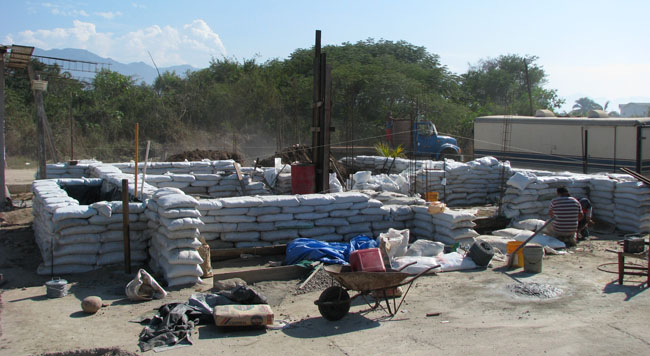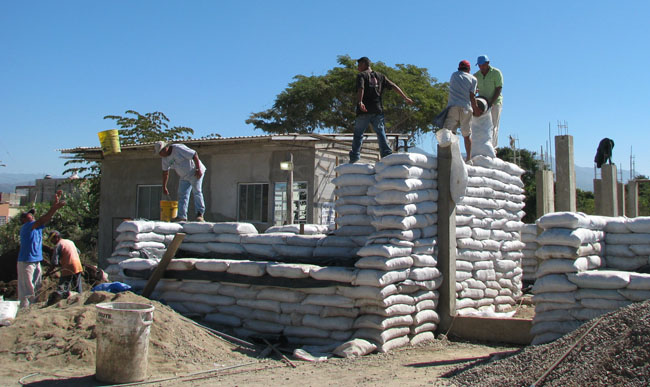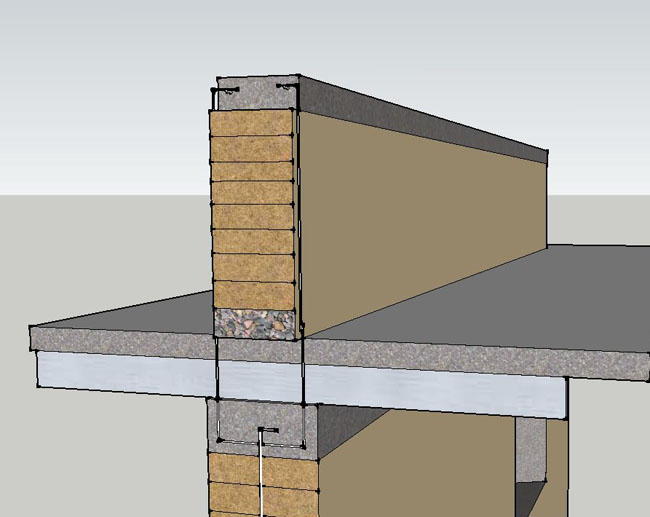I have been consulting with Mike Parker who started www.childrenofthedump.org in Puerto Vallarta, Mexico about how to build inexpensive, ecological housing for poor families who subsist off recycling materials from the city dump. They typically live in shacks and shanties that are often not adequate for their needs, nor do they provide proper housing for children who then are not able to get an adequate education to better themselves.
Puerto Vallarta is on the Pacific coast in the tropical zone of central Mexico, where the climate is generally quite hot and humid. These folks cannot afford air conditioning, so they need shelter that will help moderate the extreme heat naturally.
Mike and I have discussed a variety of ways to accomplish this and the design that we came up with should perform quite well in this regard. We are using large earthbags filled with adobe soil that provides both insulation and thermal mass. We are berming most of the structure about a meter high with substantial planter beds. We are insulating the roof with large bags of recycled styrofoam. We provide plenty of ventilation via screened openable windows, a central corridor straight through the house from door to door, and there is an openable stairwell to the roof/second floor. We exclude nearly all of the direct sunlight into the house with large overhangs and buttresses. And the breathable interior walls will help moderate the humidity as well. I think that this model home could serve most any place with a hot, humid climate.
Before I arrived in Puerto Vallarta (in January, 2011), Mike and the workers had already prepared the land, laid out the walls, dug the rubble trench foundation with a French drain, laid down three courses of bags full of gravel, and started laying the walls with adobe-filled bags.
Most the polypropylene earthbags employed were recycled from nearby bakeries. As with most bags used in Mexico, they were larger than is absolutely necessary for earthbag construction, measuring about 22″ X 39″. The people from the dump community had been saving bags gleaned from the trash for use in their own homes, and these are also mostly the larger ones. This fact means that once the bags are filled with damp adobe soil, they are very heavy, generally requiring two strong people to move them and place them on a wall. I showed them how they can be filled in place, using a bottomless bucket as a funnel and a metal slider to keep them from getting stuck on the barbed wire.
Earthquakes are not common in the Puerto Vallarta area, but they can happen, so there is always the concern of building structurally reinforced building that could withstand shaking. Standard Mexican construction takes this into consideration, using confined masonry techniques with steel-reinforced columns and bond beams that frame the common brick or concrete block construction. Mexican laborers are entirely accustomed to building this way, so this what we decided to use in framing doors and windows and creating a bond beam.
I came up with the above diagram, which shows exactly how to construct the walls, bond beams, roof rafters, roof/second floor platform, and the parapet/second story walls.
Basically what this has created is a design for a reinforced two-story earthbag building that might pass code standards for most seismic zones around the world, although I cannot guarantee this. In this particular building, the lower story walls are not reinforced the way they would be according to the specs provided by Precision Engineering, but those walls are heavily buttressed and have been reinforced with periodic vertical rebar, and tied at the bond beam with steel rafters/joists. They also have the barbed wire and the plaster wire mesh as specified. This will be a very solid building that should withstand most forces it will likely encounter during its life.
For more photos and description of this entire project see this page.





This was his reply to my email yesterday:
“We are in the process of building a model home, all the work has been done by the poor who work in the dump here in Puerto Vallarta. The project started about a year ago, then the owner of the property became involved in a land dispute. That problem has been resolved and we are now planning to finish the model home by August. We have obtained occupancy permits for 22 families that we plan to build homes for over the next year. We will have the people at the dump help build their own homes with volunteers from Puerto Vallarta, the United States and Canada. I would be very interested in your assistance and look forward to discussing the program with you. I am from Washington State and don’t speak Spanish, but my wife Maria is from Puerto Vallarta and I have a full time interpreter from 10am till 6pm. You can see some of what we are doing on our website http://www.childrenofthedump.org . Our long range goal is to build these style homes for the Middle Class in Mexico, giving jobs to our people from the dump community. You may reach me on my cell phone at 044-322-135-0500. Have a Blessed Day. Mike Parker”
Thank you for all your help and the wonderful site Mr. Geiger. I truly hope to learn more from you guys!
GB³
Antonio Found
Aterh₂sol, SA. De CV. Founding Leader
This is a great project. My Earthbag Building Guide is being translated into Spanish and hopefully it will be of assistance.
How can one participate and partner with you Mr. Parker?
He probably won’t see your comment. I suggest contacting them directly. And maybe while you’re at it, maybe ask for a quick update on their project. Have they built more earthbag houses?
You guys are awesome, God Bless you all!
inches month
0.7 Jan
1.77 Feb
0.25 Mar
0.03 Apr
0.03 May
0.11 Jun
2.61 Jul
6.15 Aug
5.64 Sep
4.22 Oct
1.4 Nov
0.28 Dec
23.19 Total
The rainy season runs from June through Mid-October, with virtually no precipication the rest of the year. Even in rainy season, the rain normally falls in short bursts, most often at night, with most days being hot and dry. Tours and fishing trips are seldom affected by the weather in Puerto Vallarta, it’s very rare.
http://www.puertovallartatours.net/weather.htm
I love this plan. Mike Parker obviously knows and cares about conditions and needs there, and Kelly’s work onsite has resulted in tremendously better ideas than long distance guesses at what might work.
The planting beds can also serve to grow food in crowded areas where the ground is usually trampled.
And for places with little space or too high groundwater for latrines, some of these beds can serve for the compost generated from night soil, or a composting toilet. Keep the human waste in sealed drums for 6 months, then start to fill a planter. Reserve the human waste planters for vines and bush fruit and small trees.
Or if there’s no space for latrines, use the peepoo bags, which neutralize waste and are ready to grow after only a month and a half in a sealed drum. Added rice hulls or other agricultural waste could lighten the soil and top it off.
My only suggestion is could sand bags with gaps between bags form the front wall of the planting beds? They wouldn’t be damaged by dampness in the bed and could allow some drainage. Sand bags might form a good 24- 30 ” height base for the buttresses without needing any cement to stabilize them also.
I wonder how much it rains there. Maybe they get some heavy rains off the ocean and additional drainage would be required at times.
I like the security aspect of having the food growing right next to the house to prevent theft. The beds make a perfect kitchen garden.
This design looks very strong and livable to me. The only other comment concerns the vertical rebar pins in the top courses. I prefer to align them with the horizontal rebar. This is done by alternating the vertical pins from side to side. Tie the horizontal steel to the vertical pins so it’s raised about 1-1/2″=2″ above the earthbags.
Your information is great. Is there a reason you are not promoting yourself on Facebook or Twitter. I have alot of people that are interested in your site I posted your info on my blog. And will share yours on my network.
Thank You.
We don’t have time for more networking sites. But we really appreciate it when others spread the word.